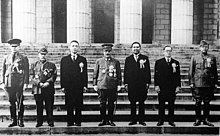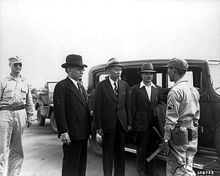
Emilio Aguinaldo y Famy was a Filipino revolutionary, statesman, and military leader who is the youngest president of the Philippines (1899–1901) and became the first president of the Philippines and of an Asian constitutional republic. He led the Philippine forces first against Spain in the Philippine Revolution (1896–1898), then in the Spanish–American War (1898), and finally against the United States during the Philippine–American War (1899–1901).

The Commonwealth of the Philippines was an unincorporated territory and commonwealth of the United States that existed from 1935 to 1946. It was established following the Tydings–McDuffie Act to replace the Insular Government of the Philippine Islands and was designed as a transitional administration in preparation for full Philippine independence. Its foreign affairs remained managed by the United States.

José Paciano Laurel y García was a Filipino politician, lawyer, and judge, who served as the President of the Japanese-occupied Second Philippine Republic, a puppet state during World War II, from 1943 to 1945. Since the administration of President Diosdado Macapagal (1961–1965), Laurel has been officially recognized by later administrations as a former president of the Philippines.
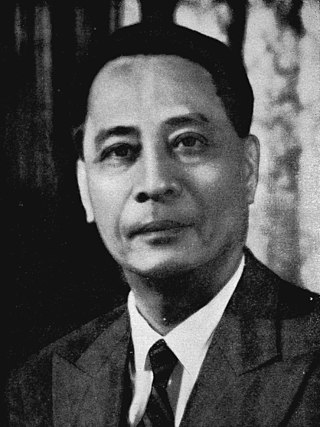
Manuel Acuña Roxas was a Filipino lawyer and politician who served as the fifth President of the Philippines from 1946 until his death in 1948. He served briefly as the third and last President of the Commonwealth of the Philippines from May 28, 1946, to July 4, 1946, and became the first President of the Independent Third Philippine Republic after the United States ceded its sovereignty over the Philippines.

Teodoro Andal Agoncillo was a prominent 20th-century Filipino historian. He and his contemporary Renato Constantino were among the first Filipino historians renowned for promoting a distinctly nationalist point of view of Filipino history. He was also an essayist and a poet.

Filipino nationalism refers to the establishment and support of a political identity associated with the modern nation-state of the Philippines, leading to a wide-ranging campaign for political, social, and economic freedom in the Philippines. This gradually emerged from various political and armed movements throughout most of the Spanish East Indies—but which has long been fragmented and inconsistent with contemporary definitions of such nationalism—as a consequence of more than three centuries of Spanish rule. These movements are characterized by the upsurge of anti-colonialist sentiments and ideals which peaked in the late 19th century led mostly by the ilustrado or landed, educated elites, whether peninsulares, insulares, or native (Indio). This served as the backbone of the first nationalist revolution in Asia, the Philippine Revolution of 1896. The modern concept would later be fully actualized upon the inception of a Philippine state with its contemporary borders after being granted independence by the United States by the 1946 Treaty of Manila.

The Philippine Republic, now officially remembered as the First Philippine Republic and also referred to by historians as the Malolos Republic, was established in Malolos, Bulacan during the Philippine Revolution against the Spanish Empire (1896–1898) and the Spanish–American War between Spain and the United States (1898) through the promulgation of the Malolos Constitution on January 22, 1899, succeeding the Revolutionary Government of the Philippines. It was formally established with Emilio Aguinaldo as president. It maintained governance until April 1, 1901.

The history of the Philippines from 1898 to 1946 is known as the American colonial period, and began with the outbreak of the Spanish–American War in April 1898, when the Philippines was still a colony of the Spanish East Indies, and concluded when the United States formally recognized the independence of the Republic of the Philippines on July 4, 1946.
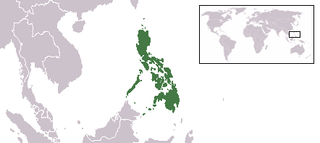
The Philippine Executive Commission was a puppet government set up to govern the Philippine archipelago during World War II. It was established with sanction from the occupying Imperial Japanese forces as an interim governing body prior to the establishment of the Japanese-backed, Second Philippine Republic.

The National Assembly of the Philippines refers to the legislature of the Commonwealth of the Philippines from 1935 to 1941, and of the Second Philippine Republic during the Japanese occupation. The National Assembly of the Commonwealth was created under the 1935 Constitution, which served as the Philippines' fundamental law to prepare it for its independence from the United States of America.
The National Assembly was the legislature of the Second Philippine Republic from September 25, 1943, to February 2, 1944.
The Preparatory Committee for Philippine Independence or the PCPI was the drafting body of the 1943 Philippine Constitution during the Japanese Occupation of the Philippines during World War II. The constitution was signed and unanimously approved on September 4, 1943, by its members and was then ratified by a popular convention of the KALIBAPI in Manila on September 7, 1943.

Benigno Simeón Quiambao Aquino Sr. was a Filipino politician who served as Speaker of the National Assembly of the Japanese-sponsored puppet state in the Philippines from 1943 to 1944.

The Kapisanan sa Paglilingkod sa Bagong Pilipinas, or KALIBAPI, was a fascist Filipino political party that served as the sole party of state during the Japanese occupation. It was intended to be a Filipino version of Japan's governing Imperial Rule Assistance Association.

Japanese invasion money, officially known as Southern Development Bank Notes, was currency issued by the Japanese Military Authority, as a replacement for local currency after the conquest of colonies and other states in World War II.
The Constitution of the Philippines is the constitution or the supreme law of the Republic of the Philippines. Its final draft was completed by the Constitutional Commission on October 12, 1986, and ratified by a nationwide plebiscite on February 2, 1987.
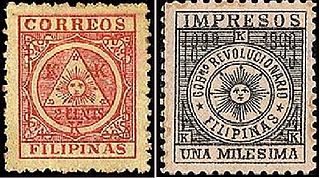
This is a survey of the postage stamps and postal history of the Philippines.
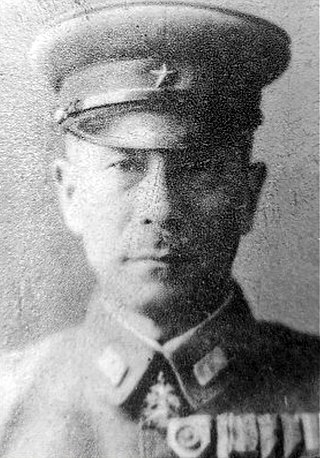
Shigenori Kuroda was a Japanese lieutenant general of the Japanese Imperial Army and the Japanese Governor-General of the Philippines during World War II.

The 1943 Philippine presidential election was held on September 25, 1943, at the midst of World War II.






